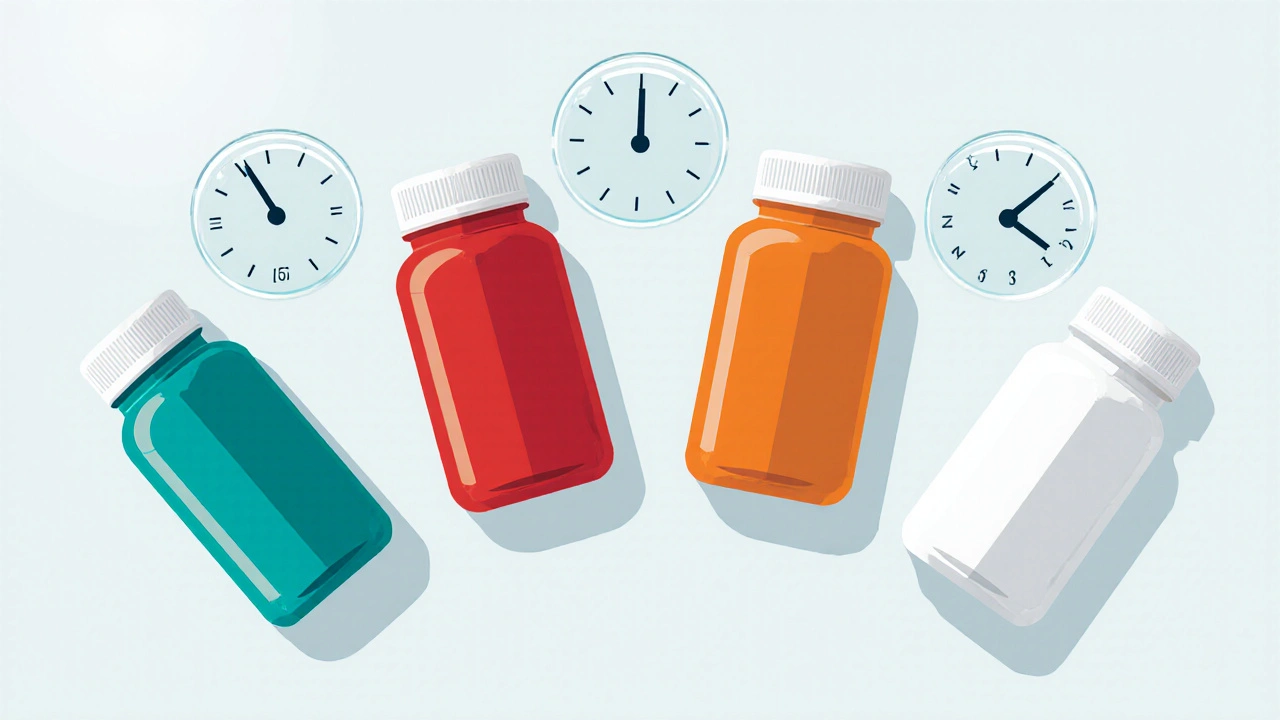Quick Takeaways
- Voveran is an opioid analgesic best for chronic moderate‑to‑severe pain.
- Non‑opioid options like ibuprofen and naproxen work well for mild‑to‑moderate pain with fewer dependence risks.
- Tramadol offers a middle ground-lower abuse potential than Voveran but still an opioid.
- Acetaminophen is safest for fever and mild pain but lacks anti‑inflammatory action.
- Cost, side‑effect profile, and prescription status should drive the final decision.
If you're weighing Voveran against other pain relievers, you probably want to know which drug eases your symptoms without breaking the bank or putting you at unnecessary risk. Below you'll find a clear breakdown of Voveran, its most common rivals, and a side‑by‑side comparison that lets you match each option to your personal health needs.
What Is Voveran?
When looking at pain management, Voveran is a centrally‑acting opioid analgesic approved for moderate‑to‑severe chronic pain. It belongs to the Opioid analgesics class, typically dosed at 10mg twice daily. The drug works by binding to mu‑opioid receptors in the brain, dulling pain signals and producing a sense of relief.
Key attributes of Voveran include:
- Onset of action: 30-45minutes
- Duration: 6-8hours
- Common side effects: constipation, nausea, drowsiness
- Contra‑indications: severe respiratory depression, active asthma, recent head injury
- UK average cost (2025): £18 per 30‑tablet pack
Because Voveran is an opioid, it is classified as Prescription‑only medicine in the UK. This means a qualified prescriber must assess your medical history, potential for misuse, and any concurrent medications before handing you a script.

Top Alternatives to Voveran
Below are the most frequently considered replacements. Each alternative is introduced with a brief profile that highlights its drug class, typical dosing, and primary pros and cons.
Tramadol
Tramadol is a synthetic opioid that provides moderate pain relief with a lower risk of respiratory depression compared to traditional opioids. It is often prescribed in 50mg tablets taken every 6-8hours.
- Onset: 1hour
- Duration: 4-6hours
- Side effects: dizziness, headache, potential for serotonin syndrome when combined with antidepressants
- Cost (2025): £12 per 30‑tablet pack
Ibuprofen
Ibuprofen is a non‑steroidal anti‑inflammatory drug (NSAID) that reduces pain, fever, and inflammation. Standard dosing is 200-400mg every 4-6hours, not exceeding 1,200mg daily without medical supervision.
- Onset: 15-30minutes
- Duration: 4-6hours
- Side effects: stomach irritation, increased blood pressure, rare kidney issues
- Cost (2025): £4 per 30‑tablet pack
Naproxen
Naproxen is another NSAID that offers longer‑lasting pain control, especially useful for musculoskeletal conditions. Typical dosage is 250mg twice daily.
- Onset: 30minutes
- Duration: 8-12hours
- Side effects: gastrointestinal upset, higher cardiovascular risk with long‑term use
- Cost (2025): £5 per 30‑tablet pack
Acetaminophen (Paracetamol)
Acetaminophen is a centrally acting analgesic and antipyretic with minimal anti‑inflammatory effect. Recommended dose is 500-1,000mg every 4-6hours, max 4g per day.
- Onset: 30minutes
- Duration: 4-6hours
- Side effects: rare, but overdose can cause severe liver damage
- Cost (2025): £3 per 30‑tablet pack
Head‑to‑Head Comparison
| Drug | Class | Typical Dose | Onset | Duration | Common Side Effects | Average Cost |
|---|---|---|---|---|---|---|
| Voveran | Opioid analgesic | 10mg PO BID | 30-45min | 6-8h | Constipation, nausea, drowsiness | £18 |
| Tramadol | Synthetic opioid | 50mg PO Q6‑8h | ≈1h | 4-6h | Dizziness, headache, serotonin interaction | £12 |
| Ibuprofen | NSAID | 200‑400mg PO Q4‑6h | 15‑30min | 4-6h | Stomach irritation, BP rise | £4 |
| Naproxen | NSAID | 250mg PO BID | 30min | 8-12h | GI upset, CV risk | £5 |
| Acetaminophen | Central analgesic | 500‑1000mg PO Q4‑6h | 30min | 4-6h | Liver toxicity (overdose) | £3 |
From the table you can see that Voveran offers the strongest pain relief but comes with higher cost and a stricter prescription requirement. If you need occasional relief for mild inflammation, ibuprofen or naproxen may be more appropriate. For patients wary of opioid dependence, tramadol provides a compromise, while acetaminophen remains the safest baseline for low‑grade pain.

Choosing the Right Option: Decision Checklist
- Assess Pain Severity: Moderate‑to‑severe chronic pain? Voveran or tramadol. Mild‑to‑moderate? NSAIDs or acetaminophen.
- Check Contra‑indications: History of ulcer disease → avoid ibuprofen/naproxen. Respiratory issues → avoid Voveran.
- Consider Abuse Potential: History of substance misuse → steer clear of opioids; choose NSAIDs or acetaminophen.
- Factor in Cost: Budget constraints favor ibuprofen, naproxen, or acetaminophen.
- Review Interaction Profile: Taking SSRIs? Be cautious with tramadol due to serotonin syndrome risk.
Use this checklist during your next GP visit to ensure the conversation stays focused on what matters most to you.
Frequently Asked Questions
Is Voveran more effective than ibuprofen for chronic pain?
Voveran, as an opioid, provides stronger analgesia for moderate‑to‑severe chronic pain compared to ibuprofen, which is mainly anti‑inflammatory. However, effectiveness must be weighed against dependence risk and higher cost.
Can I switch from Voveran to tramadol without a doctor?
No. Both drugs are prescription‑only in the UK. A clinician should evaluate your dosage, taper Voveran if needed, and then prescribe tramadol to avoid withdrawal or overdose.
Are there any over‑the‑counter alternatives to Voveran?
Over‑the‑counter options include ibuprofen, naproxen, and acetaminophen. While they lack the potency of Voveran for severe pain, they are safe for short‑term use and don’t require a prescription.
What should I do if I experience constipation on Voveran?
Talk to your GP about adding a laxative or stool softener. Increasing dietary fiber and fluid intake can also help, but never adjust the opioid dose on your own.
Is it safe to combine Voveran with acetaminophen?
Combining an opioid with acetaminophen is sometimes done under strict medical supervision to enhance pain control while keeping opioid doses lower. Only do this if your prescriber explicitly advises it.

Ashley Leonard
October 13, 2025 AT 16:56I’ve been on Voveran for a few months after my back surgery, and the way it hits that mid‑range pain is pretty solid.
What surprised me most was how quickly the constipation kicked in, so I started a high‑fiber diet and a gentle stool softener.
If you’re weighing cost, the £18 pack can add up, especially compared with a cheap ibuprofen bottle that’s under £5.
Just remember that the opioid ceiling means you’ll still need a backup for flare‑ups, and your GP should monitor liver and kidney function regularly.
Overall, it’s a tool, not a cure‑all, and balancing it with an NSAID on off‑days can keep you from getting locked into one prescription.
Ramanathan Valliyappa
October 24, 2025 AT 16:49The article mixes dosage data with cost without citing primary sources, which undermines its credibility.
lucy kindseth
November 4, 2025 AT 15:43When you decide between Voveran and an over‑the‑counter option, start by listing your pain intensity and any existing conditions.
For chronic moderate‑to‑severe pain, Voveran’s opioid strength can be justified, but only if you have no history of respiratory disease.
If you’re prone to stomach ulcers, skip ibuprofen and naproxen; acetaminophen or tramadol are safer choices.
Don’t forget to discuss potential drug interactions-especially SSRIs with tramadol-to avoid serotonin syndrome.
Lastly, keep a simple spreadsheet of weekly costs so you can see whether the £18 Voveran pack is financially sustainable.
Nymia Jones
November 15, 2025 AT 15:36It is evident that the pharmaceutical conglomerates have engineered a market wherein a potent opioid like Voveran is presented as the indispensable solution for chronic pain, thereby ensuring a perpetual demand.
Their lobbying power subtly influences prescribing guidelines, nudging clinicians toward expensive, habit‑forming agents while marginalising equally effective, low‑cost alternatives.
One must also consider the opaque supply chains that obfuscate true manufacturing costs, allowing profit margins to balloon at the expense of patients.
Consequently, the narrative that Voveran is the only rational choice for moderate‑to‑severe pain is a carefully constructed myth, propagated through selective evidence and aggressive marketing.
Patients deserve transparency; without it, the risk of dependency becomes a calculated gamble imposed by profit‑driven motives.
Karen McCormack
November 26, 2025 AT 15:29Imagine pain as a tempestuous sea, each remedy a distinct vessel navigating its tumult.
Voveran, the sleek cutter, slices through waves with raw power, yet its steel hull can scar the hull of the sailor.
Ibuprofen resembles a modest dinghy, nimble against minor swells, never daring the abyssal depths.
Naproxen, with its elongated prow, endures longer voyages, though its ballast may burden the heart.
Acetaminophen, the gentle barque, glides smoothly on calm waters, safe but limited when storms roar.
Thus, the art lies in matching the vessel to the sea you face, lest you capsize on hubris.
Earl Hutchins
December 7, 2025 AT 15:23Both Voveran and the OTC options have pros and cons you should weigh.
Opioids give strong relief but bring dependence risk.
NSAIDs cut inflammation fast yet can irritate the stomach.
Acetaminophen is gentle on the gut but lacks anti‑inflammatory action.
Talk to your doctor about your medical history and budget before deciding.